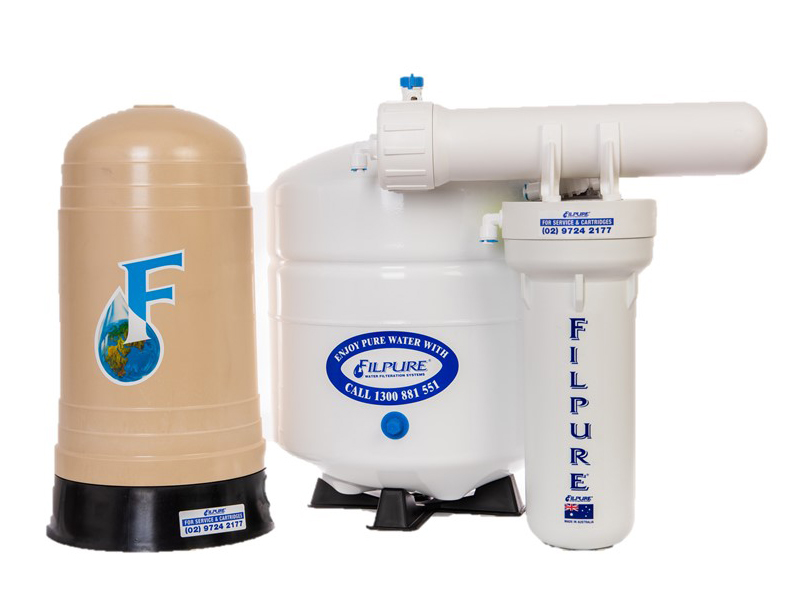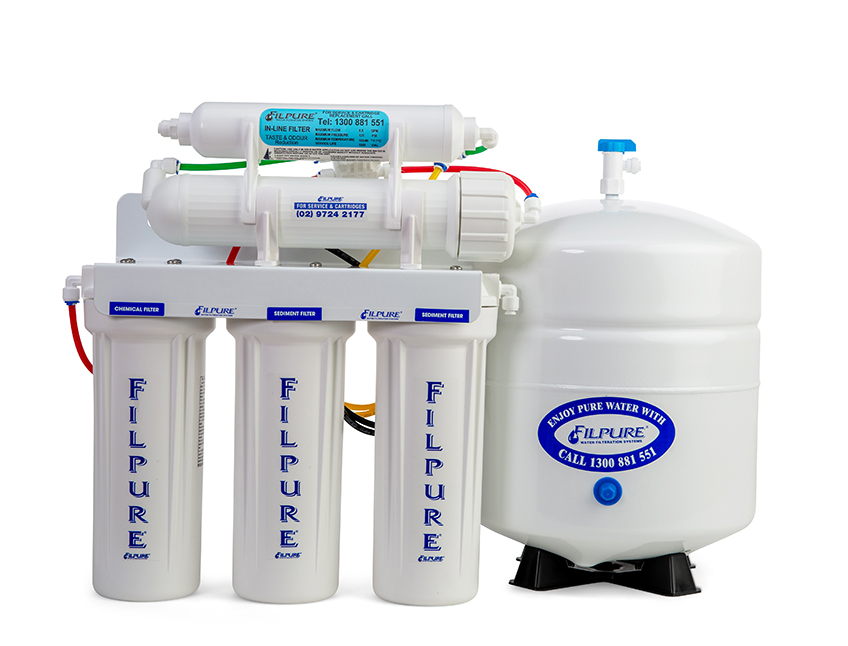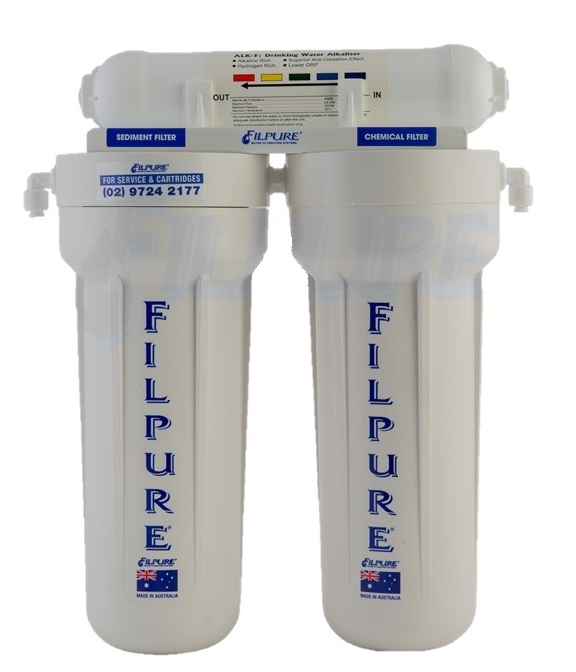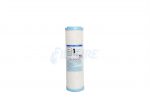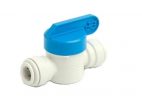F.A.Q.s
RO – FAQ
1. What is reverse osmosis (RO)?
Reverse osmosis, or RO for short, is a sophisticated water purification process that was originally designed by the U.S. Navy to provide drinking water to submarine crews from seawater. It works by forcing pressurized water through minuscule pores of a semi-permeable membrane, effectively filtering out impurities. To produce great-tasting and highly purified water in our homes today, modern RO units incorporate cutting-edge carbon and mechanical filtration technologies with this membrane filtration method.
2. How does it work?
To understand how it functions, let’s break down the process. First and foremost, the water in modern home systems is propelled by normal city water pressure and runs through a sediment pre-filter that removes any dirt and small particles present in the water. Following this, an organic contaminants-absorbing multi-stage pre-filter filters out chlorine along with its by-products. This treated water then enters what is called a membrane – which is essentially a very tight, sheet-like filter – which allows pure water to pass through but rejects dissolved solids as well as impurities such as lead, arsenic, and sodium. Furthermore, to cleanse the surface of the membrane itself, some of the incoming water is used before being drained out via pipes beneath your sink (kitchen drainpipes). The clean purified drinking water generated by our unit gets stored in a small tank until needed. Finally, when you open your faucet attached to our system placed over your sink; this purified drinking water flows through another carbon filter which polishes it further making it ready for safe consumption. However, there are additional instruments that contribute significantly to ensure purification quality such as flow control devices and check valves among others together play an important role that goes beyond just the filtration mechanism alone- but we’ll save those details for another day.
3. What is the best RO system?
When it comes to choosing the best RO system, it’s important to consider the features that each model offers. While all RO membranes produce highly purified water, not all systems are created equal. For example, the F5 is perfect for city water applications and boasts a Seven-stage filtration process that removes even the smallest of contaminants. The F5 considers water conservation with a high-efficiency design that produces more water in less time while using less water than traditional RO systems. And for consumers looking for a low-maintenance premium system, the F5 offers a Stainless steel designer faucet, Lead-free stainless-steel storage tank. When it comes to choosing the best RO system, there is no one-size-fits-all solution- but by taking into account your unique needs and preferences you can find one that works perfectly for you.
4. Is an RO unit like a distiller?
When considering whether to use an RO unit or a distiller for water treatment, it’s important to understand their differences. While both methods are effective at reducing the amount of dissolved solids in water, they utilize distinct processes. Specifically, RO filtration works by using a tightly-woven semi-permeable membrane, whereas a distiller functions like a large kettle that boils water and collects the resulting steam. Carbon filtration is essential for both methods to remove chemicals. It should be noted that low-cost distillers often lack carbon filters and may not provide adequate results.
5. Is distilled water purer than RO water?
When it comes to determining which type of water is purer, there are some differences between distilled water and reverse osmosis (RO) water. Distillers tend to remove slightly more mineral constituents, such as sodium, but may not be as efficient when it comes to eliminating volatile chemicals like chloramines. Many cities have started using these disinfectants instead of chlorine, and they can be difficult for distillers to remove completely. On the other hand, RO with carbon filtration does an excellent job of removing evidence of chloramines. It’s important to note that without proper carbon filtration before distillation, any volatile chemicals will end up in either the air or your distilled water. Despite these differences in approach, both methods produce highly pure water.
6. Do RO units waste a lot of water?
The amount of water that an RO (reverse osmosis) unit uses can be a point of concern. In reality, the answer to this question is contextual. An RO unit utilizes water during its cleaning cycle and eliminates impurities, which is consistent with how most water-based appliances work. When you compare it to other daily activities such as washing dishes or clothes, flushing toilets, or hosing your car down, an RO unit consumes more water than you drink. However, once the storage tank has filled up, the unit disengages, and pipes no longer flow—all in all, it’s equivalent to adding two or three toilet flushes a day to your general usage.
7. What are the yearly expenses for maintenance?
pre and post-filters need to be changed annually to make sure they are functioning correctly. the rate of filter changes will depend on the quality of the water and the usage. the yearly cost is less than $0.40 per day, depending on the point-of-use RO model. The RO membrane usually lasts for two to five years.
8. What is the importance of water pressure for an RO system?
It is essential. The water pressure forces the water through the membrane to clean and wash away the solids. Low water pressure reduces production and premature fouling of the membrane. The ideal pressure to use an RO system is 60 PSI. Pressure below 0 PSI is generally considered insufficient and must be raised with a booster pump.
9. Can I connect the RO unit to a refrigerator/ice maker?
Yes, but only if you have 1/4 ” pipe access to the under-sink RO unit. Some refrigerators measure pressure, so you should check with the manufacturer. The pressure of the RO unit is about 2/3 of the inlet pressure.
10. How long does the RO unit last?
Almost forever if you maintain it regularly and replace wearing parts like the storage tank and mixer. The typical life of the membrane is about 2-5 years, depending on the quality of the treated water.
11. Does RO remove chlorine?
Although the RO membrane itself does not remove chlorine, it does not have to. A pair of quality carbon filters will do the job. If the first carbon filter does not remove all the chlorine, the membrane would quickly eat away.
12. Do RO units remove minerals important to health?
RO units remove approximately 95% of the mineral content, but the issue of minerals is probably the most controversial in drinking water treatment. Experts on both sides speak convincingly. As long as the water tastes good, it is within the body’s acceptable range. The main problem with water is chemicals, not minerals. Whether water contains 30 parts per million or 3 parts per million of calcium is not nearly as important as the difference between 0.5 parts per million and 5 parts per million of chloroform.
13. Do RO units need electricity?
No, they work with water pressure. You only need electricity if you add an electric booster pump or an ultraviolet lamp. Standard devices have neither.
14. Why are RO units so popular?
Because they produce great tasting, ultra-pure water at a reasonable price compared to buying bottled water, and they start up fully automatically with no problems. Dedicated water drinkers know that not all water tastes the same.
15. Can a water softener harm RO?
No, a water softener can help extend the life of your RO membrane. Calcium and magnesium (limestone) are the two hardest minerals for an RO membrane to remove, and sodium (which is added to the water using a water softener) is much easier on the membrane because it repels 98% of the sodium in the water.
16. How many and what type of sites could be affected by PFAS?
Because PFAS have been used in a wide variety of applications over time and they do not fully break down naturally, they are present in low levels almost everywhere in the environment. Increased levels of PFAS can be found near sewage treatment plants, landfills, and places where fire-fighting foams have been used (e.g. mining operations, fuel refineries and storage facilities, airports, fire-training grounds and transport infrastructure). Consequently, these chemicals are found in many places and are not just limited to Commonwealth-owned sites.
The Department of Defence has a comprehensive PFAS Investigation and Management Program underway, which has identified around 27 Defence sites that are now either undergoing investigations or have reached the stage of determining management options. Airservices Australia’s National PFAS Management Program is also conducting assessments of sites where it has provided aviation fire and rescue services.
The Department of Infrastructure, Transport, Regional Development, Communications and the Arts is undertaking the Australian Government’s $130.5 million PFAS Airports Investigation Program at airports where the Commonwealth historically provided firefighting services using PFAS-containing foams.
State and territory governments are conducting their own investigations of state-owned sites. For example, fire fighters may have used fire-fighting foams containing PFAS at training sites. Visit our PFAS Advice page for information about PFAS activities in your jurisdiction.
17. What does it mean if I live in a PFAS contaminated area?
The Australian Government is working closely with affected communities to help them understand what PFAS contamination means for them and their daily lives.
Advice on reducing exposure to PFAS will vary with each location due to local circumstances so community members should follow the most current advice provided by the investigating agency’s human health risk assessment and state or territory advice for their local area. People wanting to discuss personal health issues should talk to their local GP.
18. What about future contamination by PFAS?
Since 2002, the Australian Government Australian Industrial Chemicals Introduction Scheme (formally NICNAS) has published a number of alerts on PFAS. AICIS has recommended that:
- PFOS, PFOA and other related chemicals should continue to be restricted to essential uses where less hazardous alternatives are not available.
- PFOS-based fire-fighting foam should only be used in essential applications (i.e. not be used for training purposes).
- Industry should actively seek alternatives to and phase out PFAS and PFAS-related substances of concern.
- Existing stocks of PFAS fire-fighting foams should be disposed of responsibly on expiry.
- Importers and users of PFAS should be aware of international activities relating to PFAS.
- Importers should ensure that alternative chemicals are less toxic and not persistent in the environment.
- Up-to-date information on safe use of PFAS and handling should be provided on labels and Safety Data Sheets.
A large body of work is underway across Australia – both to manage existing contamination and to increase our ability to prevent further contamination from PFAS and other industrial chemicals of concern.
19. How are people exposed to PFAS?
Most people living in Australia will have detectable levels of PFAS in their blood. Exposure to PFAS can be from a variety of sources such as food packaging, non-stick cookware and stain protection applications for fabrics and carpets.
There are a number of specific sites across Australia, where concentrated releases of PFAS have resulted in increased levels of PFAS in surrounding soil, water and produce. Visit our PFAS Advice page for links to identified investigations areas near you.
For most people in PFAS affected areas, the highest risk of exposure is likely to be through the consumption of contaminated groundwater (i.e. bore water) and food grown using contaminated ground water.
Outside of the identified investigation areas, unless you live near industrial areas, landfill sites, or firefighting training grounds where PFAS-containing foams were used, it is unlikely that increased levels of PFAS would be present in your local environment.
The Department of Health has produced a factsheet on exposure pathways:
20. If there are no proven harmful human health effects from exposure to PFAS, why have precautions been put in place?
The precautions put in place are just that – precautions. While we know these chemicals can persist in humans, animals and the environment, there is currently limited understanding of the human health effects of long-term PFAS exposure. Therefore, as a precaution governments in Australia recommend that exposure be reduced wherever possible while research into any potential health effects continues.
21. How can I find out what the level of PFAS in my blood means for me?
If you have your blood tested for PFAS, you should talk to your GP about what the results mean for you.
A blood test can measure the level of PFAS in a person’s blood. If PFAS is detected, this tells a person that they have been exposed to PFAS. However, these tests are not routine and there is at present insufficient scientific evidence for a medical practitioner to be able to tell a person whether their blood level will make them sick now or later in life, or if any current health problems are related to the PFAS levels found in their blood. As such, blood tests have no diagnostic or prognostic value.
At a population level, blood tests can inform a community that they have been exposed to PFAS at a level above that of the general population. Monitoring pooled community blood samples over time may help determine the success of exposure reduction measures in reducing blood levels of PFAS.
22. Is my food safe to eat?
Australia has an effective, robust food regulation system in place to ensure the safety of our food.
For the general food supply, it is considered extremely unlikely that consumption of a specific food group over a period would all be from food sourced locally from a contaminated site. For example, milk on the supermarket shelf does not normally come from just one dairy farm, but is sourced from many farms, mixed and distributed through retail outlets. While this may mean low levels of PFAS are still present, Food Standards Australia New Zealand (FSANZ) found dietary exposure to PFOS, PFOA and PFHxS from the general food supply is unlikely to exceed the Tolerable Daily Intakes.
Data available to date suggests that dietary exposure to PFOS, PFOA and PFHxS in the general food supply is likely to be low. In 2016, FSANZ performed an analysis of PFAS chemicals in a range of foods representative of the Australian diet, sampled from outlets such as supermarkets, corner stores, delicatessens, markets and takeaway shops, representing the buying habits of most of the community. The analysis found no detections for PFOA and only two detections for PFOS out of 50 foods tested. The concentrations of PFOS were at very low levels and similar to those reported internationally for the same foods.
FSANZ is undertaking further monitoring of PFAS in the general food supply as part of the next routine Australian Total Diet Study. Visit FSANZ’s website for more information.
State and territory governments are responsible for food regulation in Australia and are the appropriate authorities to issue food advisories to the public regarding any food contaminant, including PFAS.
23. What should I do if I produce food on or near a site affected by PFAS contamination?
Where food safety regulators consider action is required to manage exposure through food, maximum limits for contaminants in the environment are set. To date, no maximum limits have been set for PFAS contaminants in food by Australian regulators nor internationally. Consequently there are no current restrictions on domestic or international trade in agricultural or aquaculture products.
Some people do consume certain foods which are primarily sourced near a contaminated site – for example, farmers who raise and consume their own animals. These people may reach the Tolerable Daily Intake for PFOS and PFHxS when they consume their usual amounts of that food. Because of this, people living near PFAS contaminated sites may be advised by the investigating agency or the state health authority to reduce their consumption of some of their own produce to minimise PFAS exposure. This advice is site-specific, is provided directly to the individuals affected, and does not apply to the general population.
SAFEMEAT has published a factsheet on PFAS for producers. SAFEMEAT is a partnership between the red meat and livestock industry and state and federal governments of Australia to ensure products achieve the highest standards of safety and hygiene from the farm to the consumer.
For more information, visit our PFAS in food and water page and our PFAS Advice page.
24. Can I eat the fish I catch in water that contains PFAS?
Fish (or other aquatic animals) that live in PFAS-contaminated waters may contain PFAS. In some instances, if you consume too much fish from PFAS-contaminated waters, you may exceed the Tolerable Daily Intakes for PFOS, PFOA and PFHxS.
Where fishing waters are near a PFAS contaminated site, the investigating agency or the state or territory government will provide advice on whether eating the fish is safe. This advice may include precautionary signage erected in affected areas. Visit our PFAS Advice page to find who to contact about the most current advice for your fishing location.
25. Can I swim in water containing PFAS?
Where recreational waters are near a PFAS contaminated site, the investigating agency or the state or territory government will provide advice on whether swimming is safe. This advice may include precautionary signage erected in affected areas. Visit our PFAS Advice page to find who to contact about the most current advice for your swimming location.
The National Health and Medical Research Council has published recreational water guidelines for PFAS. For more information, see:
26. Is my drinking water safe?
For most people living in PFAS affected areas, the highest risk of exposure is likely to be through the consumption of contaminated groundwater (i.e. bore water) and food grown using contaminated groundwater.
Precautionary advice on reducing exposure to PFAS will vary with each location due to local conditions, so you should follow the most current advice provided by the investigating agency or the state or territory government advice for your area. This advice may include precautionary signage erected in affected areas.
Visit our PFAS Advice page to find who to contact about the most current advice in your location.
The National Health and Medical Research Council has published drinking water guidelines for PFAS. For more information, see:
27. What action is the Australian Government taking on PFAS?
Australian Governments have taken a precautionary approach to managing existing PFAS contamination, working to prevent or reduce environmental and human PFAS exposure wherever possible. Efforts have mainly been directed at dealing with contamination created by historical use of these chemicals by:
- Conducting investigations across Australia to establish a greater understanding of the extent of contamination and likely impacts on surrounding communities, and where necessary, developing management strategies tailored to the unique conditions of the site.
- Where identified, ensuring PFAS exposure pathways are broken wherever possible, primarily by providing alternative water where necessary and providing advice to affected communities on other ways to reduce their exposure.
- Providing community support, information and advice.
- Investing in closing the knowledge gaps on the health effects of PFAS, and developing remediation strategies, through funding research.
- Reviewing environmental legislation with a view to better regulation of PFAS and other emerging contaminants.
- Developing guidance for all site managers to respond to PFAS contamination appropriately.
- Increasing coordination and collaboration between all levels of government and across the Commonwealth.
28. Why are there so many different government agencies involved in responding to PFAS contamination?
Responsibility for regulation of industrial chemicals at each stage of their ‘lifecycle’ is shared across the Commonwealth, states and territories. The lifecycle of a chemical includes manufacture, import, export, use, disposal and destruction. All Australian Governments have been working together to develop a system that will better manage chemical use. For further information, visit the Department of Climate Change, Energy, the Environment and Water website.
Governments across Australia also came together to develop the Intergovernmental Agreement on a National Framework for Responding to PFAS Contamination, to improve communication, information-sharing and collaboration to ensure better outcomes for affected communities. The Intergovernmental Agreement was reviewed by the Commonwealth and state and territory governments during 2019.
29. Why does it take so long to release site investigation results?
Site investigations involve thorough and detailed scientific work. These usually take between two to three years each and site owners are working towards completing them in 12-18 months. The Government is committed to being open and transparent with potentially affected communities about the progress and findings of these investigations.
The results of site investigations are released as quickly as possible and those living in affected communities are the first people we talk to.
30. Why hasn’t the Australian Government ratified the Stockholm Convention?
To ratify the listing of PFOS and PFOA under the Stockholm Convention, Australia must first be able to meet the associated management obligations.
To enable this, governments are working together to establish a National Standard for the Environmental Risk Management of Industrial Chemicals. The National Standard will set a nationally consistent environmental management approach for the use and disposal of industrial chemicals, including PFAS. The National Standard will be established by Commonwealth framework legislation, and implemented in regulatory frameworks in each jurisdiction. Work on framework legislation to establish the National Standard is currently underway. The National Standard will also form part of a national legislative framework that would support the Australian Government in deciding whether to ratify the listing of PFOA and PFOA (and any future listings) under the Stockholm Convention.
Once the Australian government can be confident in our ability to meet the obligations required under the Stockholm Convention, the Parliamentary Joint Standing Committee on Treaties will consider whether ratifying the listing of PFOS is in the national interest. This is part of Australia’s treaty-making process.
For more information on the Stockholm Convention, visit our International Cooperation page.
31. Are PFAS containing fire-fighting foams still being used in Australia?
Fire-fighting foams containing PFAS have been used in fire training drills and emergencies by the public and private sectors in Australia and worldwide for more than three decades.
The Australian Government has worked since 2002 to reduce the use of certain PFAS. As far as we know at this point in time, the biggest source of concentrated emissions of PFAS in Australia is from historical use of PFAS-containing fire-fighting foams, particularly at fire-fighting training grounds. Use of these fire-fighting foams has been significantly reduced and discontinued in most cases.
In 2003 Airservices Australia began phasing out PFAS-containing fire-fighting foams at all civilian airports where it operates, and has not used them at civilian-only airports since 2010.
From 2004, the Department of Defence commenced phasing out its use of PFOS and PFOA-containing fire-fighting foams and switched to ‘Ansulite’, which only contains trace elements of PFOS/PFOA and is only used in emergency situations or in controlled environments to test equipment. The Department of Defence is currently undertaking a review of alternative fire-fighting foams that meet capability requirements as well as environmental protection requirements.
32. Are PFAS fire-fighting foams used to combat Australian bushfires?
Firefighters sometimes add chemical products to the water they use to fight fires. These chemical products are broadly categorised as ‘foams’, ‘gels’, or ‘retardants’.
Foams are either sprayed onto a fire directly by a firefighter or onto threatened structures in the form of compressed air foam. Gels are sprayed onto structures in the path of a fire by a firefighter and provide a protective layer that stops the structure from catching alight. Retardants are typically dropped from an aircraft either directly onto the fire, or in front of the fire to form a fire-break.
The foams that are used to fight bushfires, or fires involving ordinary combustible material, are usually ‘Class A’ foams. Class A foams do not contain PFAS. The foams that are used to fight liquid fuel fires (for example: petrol, diesel, avgas, lubrication oil) are ‘Class B’ foams. Some Class B foams contain PFAS, but these types of foams are not intended for use on bushfires. Gels and retardants do not contain PFAS chemicals.
33. Are products used for fighting bushfires toxic?
The foam, gel and retardant chemical products that are used to fight Australian bushfires have undergone stringent testing by the United States Forest Service. This data has been analysed and accepted by the Australasian Fire and Emergency Service Authorities Council, which is the peak body for public sector fire, land management and emergency service organisations in Australia and New Zealand.
The chemicals contained in the foams, gels and retardants used in Australian bushfire fighting should not have long-lasting toxic effects in the environment.
34. What’s the difference between PFOA (C-8) and PFAS?
Per- and polyfluoroalkyl substances (or ‘PFAS’) are a group of over 4,000 manufactured chemicals. Perfluorooctanoic acid (PFOA) is one member of the PFAS family. PFOA is sometimes referred to as ‘C-8’ because it contains a chain of eight carbon atoms.
PFOA, along with perfluorooctane sulfonate (PFOS) and perfluorohexanoic acid (PFHxS) are probably the most well-known members of the PFAS family. All three of these chemicals are considered to be ‘long-chain’ PFAS because they contain a long chain of carbon atoms that are fully saturated with fluorine. All three chemicals also contain a ‘head group’ at one end of the chain, which plays a significant role in the molecule’s relative toxicity.
PFOA, PFOS and PFHxS are chemicals of concern because they are highly mobile in water (so travel long distances from their source); do not fully break down naturally in the environment; and are toxic to a range of animals. However, not all PFAS have these properties. For example, PFAS with short carbon chains are generally of lower concern than the long chain PFAS like PFOA, PFOS and PFHxS.
35. Is PFOA manufactured in Australia?
The Australian Government collects and reviews data on chemicals that are manufactured in Australia through the Australian Industrial Chemicals Introduction Scheme (AICIS). The information gathered by AICIS indicates that PFOA is not manufactured in Australia. This is also the case for PFOS and PFHxS. The information from AICIS also indicates Teflon is not manufactured in Australia.
36. What’s Teflon made of? What’s the link between Teflon and PFOA?
TeflonTM is a trade name for the chemical ‘polytetrafluoroethylene’ (PTFE). PTFE is a member of the PFAS family but it has a different structure from PFOA, PFOS or PFHxS, which gives it different properties.
There are several important differences between the properties of Teflon (PTFE) and PFOA/PFOS/PFHxS:
- PTFE is not soluble in water – PFOA, PFOS and PFHxS are soluble in water.
- PTFE is too large and too insoluble to be absorbed by organisms – PFOA, PFOS and PFHxS are readily absorbed by organisms that eat/drink contaminated food/water.
- PTFE is not toxic to animals – PFOA, PFOS and PFHxS have a range of toxic effects in animals.
These differences mean that regulators do not consider PTFE (Teflon) to be a chemical of concern to human health or the environment.
The link between PFOA and Teflon is that PFOA is used to help make Teflon. However, it is important to emphasise that PFOA is not an ingredient in Teflon—it is simply added to the reaction vessel to help make Teflon, and is removed at the end of the process. Therefore, Teflon should not contain PFOA. There are strict standards in place to help ensure that Teflon does not contain PFOA.
37. Could the same thing that happened in Dark Waters happen here in Australia?
Dark Waters showed a chemical manufacturer dumping large quantities of contaminated waste into the environment. This waste came from a plant that manufactured Teflon using PFOA. Large quantities of contaminated waste (at least 7000 tonnes) were buried and the PFOA leached out of the waste containers into the environment. This led to very high concentrations of PFOA in the ground water, creeks and rivers in the surrounding area.
There are no manufacturing plants for PFOA, PFOS, PFHxS or Teflon (PTFE) in Australia so the same thing should not happen here.


